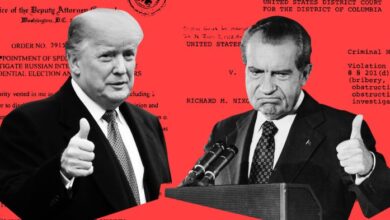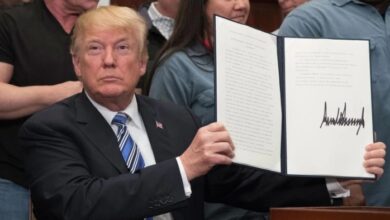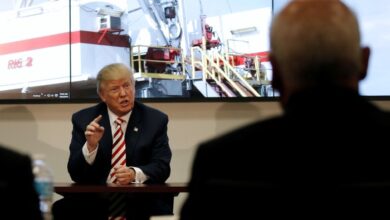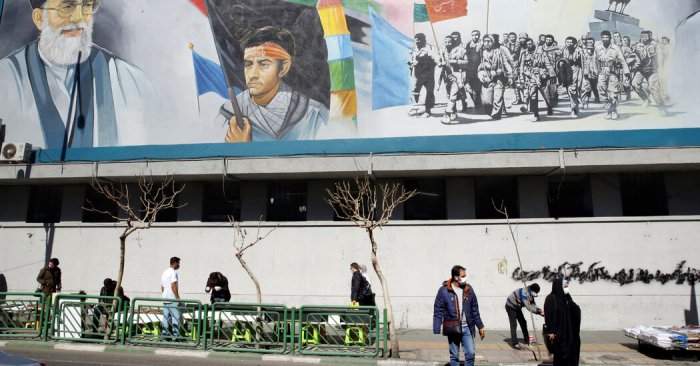
Trump Iran nuclear program talk dominated headlines, and this in-depth look delves into the intricate history of US-Iran relations, exploring the policies of different administrations and the ripple effects on the region. From the historical context of the conflict to the potential for future negotiations, we’ll analyze the complex factors surrounding this critical issue.
This analysis examines the Trump administration’s approach, contrasting it with previous administrations’ policies. We’ll explore Iran’s response, the economic consequences for both countries, and the role of the international community. The potential for future negotiations and the regional impact will also be examined, including the perspectives of various regional actors.
Historical Context of US-Iran Relations
The relationship between the United States and Iran has been fraught with complexities and shifting alliances, marked by periods of cooperation and intense conflict. This intricate history profoundly influences the current dynamic, particularly regarding Iran’s nuclear program. Understanding the historical context is crucial for comprehending the present tensions and potential future trajectories.The evolution of US-Iran relations has been shaped by a series of events, from the 1953 Iranian coup d’état to the 1979 Iranian Revolution and subsequent hostage crisis.
These turning points have left deep-seated mistrust and animosity, influencing the geopolitical landscape of the Middle East. The nuclear issue further complicates matters, as concerns over proliferation intertwine with historical grievances and present-day geopolitical considerations.
Key Events and Turning Points in US-Iran Relations
The history of US-Iran relations is characterized by a pattern of escalating tensions and moments of tentative rapprochement. These events have had a profound impact on the current geopolitical landscape.
| Date | Event | Key Actors |
|---|---|---|
| 1953 | CIA-backed coup overthrows democratically elected Prime Minister Mohammad Mosaddegh. | United States, Iran, Mohammad Mosaddegh |
| 1979 | Iranian Revolution. Ayatollah Khomeini leads the revolution and establishes an Islamic Republic. | United States, Iran, Ayatollah Khomeini |
| 1979 | Iranian Hostage Crisis. American diplomats are held hostage in Tehran. | United States, Iran, Jimmy Carter |
| 1980-1988 | Iran-Iraq War. This conflict further destabilizes the region and draws in various international players. | Iran, Iraq, United States, other international actors |
| 1980s-1990s | Growing concerns about Iran’s nuclear ambitions. | United States, Iran, international nuclear organizations |
| 2003 | US invasion of Iraq. This event impacted regional dynamics and security, affecting relations with Iran. | United States, Iraq, Iran |
| 2015 | Joint Comprehensive Plan of Action (JCPOA) signed. This agreement limits Iran’s nuclear activities in exchange for sanctions relief. | United States, Iran, other world powers |
| 2018 | US withdrawal from the JCPOA. | United States, Iran, other world powers |
Evolution of Tensions Regarding Nuclear Proliferation
The question of Iran’s nuclear program has been a central point of contention in US-Iran relations. Concerns over potential proliferation have been voiced by various US administrations, leading to different strategies and responses.The initial concerns over Iran’s nuclear ambitions stemmed from the perception that Iran’s enrichment program might be used to develop nuclear weapons. This perception was amplified by Iran’s opaque actions and interactions with other actors in the region.
The international community, led by the United States, imposed sanctions and sought diplomatic solutions.
Different US Administrations’ Approaches to Iran’s Nuclear Program
US administrations have adopted diverse approaches to Iran’s nuclear program, reflecting evolving geopolitical considerations and domestic pressures. The approach of each administration has been a direct response to the perceived threats and opportunities.
- Pre-JCPOA: Emphasis on sanctions and containment, aiming to curb Iran’s nuclear ambitions through isolation and economic pressure.
- Post-JCPOA: Initial optimism and engagement with the JCPOA, seeking a diplomatic solution. The JCPOA was intended to address the threat of proliferation, while ensuring the international community could verify the extent of Iran’s enrichment program.
- Post-Withdrawal: Return to a more confrontational approach, with the re-imposition of sanctions and increased military presence in the region.
Major Figures and Their Roles
Several figures have played crucial roles in shaping the US-Iran dynamic, including Presidents and key diplomats. Their actions and policies have significantly impacted the course of relations.
- President Carter: Faced the Iranian hostage crisis and initially responded with sanctions and diplomatic pressure.
- President Reagan: Continued the policy of sanctions and containment, while engaging in diplomatic efforts.
- President Obama: Pioneered the JCPOA, a landmark diplomatic agreement aimed at curbing Iran’s nuclear ambitions through negotiation.
- President Trump: Withdrew the US from the JCPOA and adopted a more confrontational approach.
Trump Administration’s Policies Towards Iran: Trump Iran Nuclear Program Talk
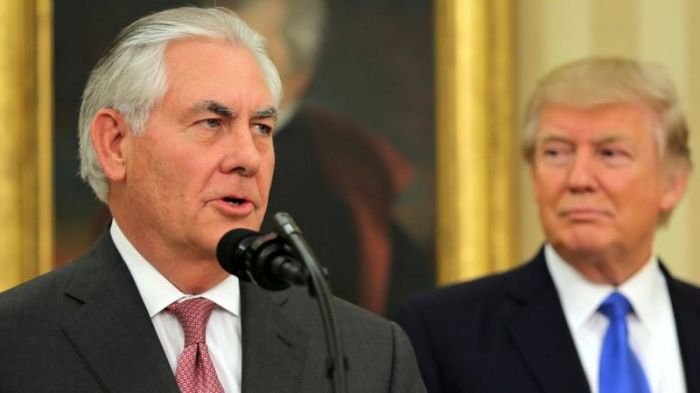
The Trump administration’s approach to Iran, particularly regarding the Iran nuclear deal, marked a significant departure from previous US policies. This shift, driven by a complex interplay of political motivations and perceived security concerns, fundamentally altered the bilateral relationship and had far-reaching consequences for the region. The administration’s actions were met with both support and criticism, raising important questions about the long-term implications of their policies.The Trump administration’s policies towards Iran were characterized by a pronounced skepticism towards the 2015 Iran nuclear deal, formally known as the Joint Comprehensive Plan of Action (JCPOA).
This stance stemmed from a belief that the deal did not sufficiently address Iran’s broader regional influence and destabilizing actions, including its ballistic missile program and support for proxy groups. These concerns, coupled with a desire to pursue a more assertive foreign policy, led to a concerted effort to renegotiate or dismantle the agreement.
Specific Policies Regarding the Iran Nuclear Deal
The Trump administration’s primary policy regarding the Iran nuclear deal was its unilateral withdrawal from the agreement in May 2018. This action effectively nullified the international accord, paving the way for the re-imposition of US sanctions that had been suspended under the JCPOA. The administration’s rationale for withdrawing was rooted in its assessment that the deal was flawed and inadequate in preventing Iran from developing nuclear weapons.
Motivations Behind the Policies
Multiple factors motivated the Trump administration’s stance. Concerns about Iran’s nuclear ambitions and its regional behavior were paramount. A desire to pursue a more robust foreign policy, challenging existing international agreements, was another key driver. Finally, domestic political considerations and the administration’s broader strategic objectives also played a significant role.
Rationale for Withdrawing from the Iran Nuclear Deal
The rationale for withdrawing from the JCPOA centered on the belief that the agreement did not adequately address Iran’s long-term nuclear intentions and its destabilizing actions in the Middle East. Critics of the deal argued that it provided Iran with significant economic relief without sufficiently constraining its nuclear activities or its support for regional proxies. The Trump administration asserted that the deal failed to prevent Iran from developing a nuclear weapons capability and that the agreement’s limitations were insufficient to counter Iran’s broader malign influence.
Trump’s Iran nuclear talks were definitely a hot topic, but how do institutions like Harvard, a major player on the world stage, actually fund their operations? Understanding how Harvard’s funding works, for example, through endowments and donations, provides context for the complex political landscape surrounding such talks. Ultimately, the intricate web of financial support behind institutions like Harvard, as detailed in this article how harvards funding works , sheds light on the bigger picture of the Iran nuclear talks and the global financial forces at play.
“The Iran nuclear deal is a disaster. It’s a very bad deal.”
Donald Trump, 2018
Comparison with Previous Administrations
The Trump administration’s approach to Iran contrasted sharply with that of previous administrations, particularly the Obama administration, which played a pivotal role in negotiating and implementing the JCPOA. The Obama administration prioritized diplomacy and international cooperation in addressing the Iranian nuclear threat, while the Trump administration favored a more confrontational approach, emphasizing sanctions and unilateral action.
Key Sanctions Imposed by the Trump Administration
The Trump administration re-imposed and strengthened numerous sanctions against Iran, targeting various sectors of the Iranian economy. These sanctions aimed to cripple Iran’s ability to fund its nuclear program and its regional activities. The sanctions were intended to isolate Iran and pressure it to change its behavior.
| Sanction Category | Specific Actions | Rationale |
|---|---|---|
| Financial Sanctions | Restrictions on Iranian financial transactions, freezing of assets, and prohibitions on trade with certain entities | To curtail Iran’s ability to conduct international financial transactions and limit its access to capital |
| Energy Sanctions | Restrictions on Iranian oil exports, prohibiting countries from importing Iranian oil | To severely impact Iran’s crucial oil revenue and limit its ability to generate income |
| Shipping Sanctions | Restrictions on shipping and trade involving Iranian vessels | To limit Iran’s ability to conduct maritime trade and engage in international commerce |
| Banking Sanctions | Restrictions on Iranian banks and financial institutions, limiting their access to international banking systems | To isolate Iranian financial institutions and limit their ability to operate in the global financial network |
Iran’s Response to Trump Policies
The Trump administration’s 2018 withdrawal from the Iran nuclear deal and subsequent re-imposition of sanctions triggered a significant and multifaceted response from Iran. This response encompassed a range of actions, from escalating nuclear activities to adopting assertive regional postures. The impact on Iran’s economy and regional stability was profound, creating a complex dynamic between the two nations.
Iranian Reactions to Sanctions and Withdrawal
Iran’s response to the Trump administration’s actions was swift and multifaceted. The withdrawal from the JCPOA, coupled with the re-imposition of sanctions, significantly impacted Iran’s economy and international standing. Iran’s government and leadership publicly condemned the US actions, viewing them as a violation of international agreements and an act of hostility.
Nuclear Advancements
Following the withdrawal from the JCPOA, Iran’s nuclear program experienced notable advancements. Public statements from Iranian officials emphasized the country’s right to pursue its nuclear program for peaceful purposes. While Iran maintained that its program remained within the confines of the NPT, its actions and declarations indicated a shift towards greater nuclear activity, raising concerns about the program’s potential to produce nuclear weapons.
Economic Impact of Sanctions, Trump iran nuclear program talk
The re-imposed sanctions severely hampered Iran’s economy. Restrictions on trade and access to international financial markets led to a significant decline in economic activity, increasing unemployment and poverty. The sanctions significantly impacted Iran’s ability to import essential goods and export its oil, creating a crisis of supply and demand within the nation. The impact was felt across various sectors, from energy to transportation.
Impact on Regional Stability
The escalating tensions between the US and Iran, fuelled by the Trump administration’s policies, had a destabilizing effect on regional stability. The increased Iranian assertiveness in the Middle East and the involvement of regional proxies in conflicts raised concerns about the spread of instability and conflict. This created a domino effect of conflicts that involved several countries in the region.
Trump’s recent talks with Iran regarding their nuclear program are certainly interesting, but the complexities of international diplomacy often get overshadowed by other pressing global issues. For example, the Ecuadorian presidential election results, particularly concerning the alleged crimes and fraud surrounding Daniel Noboa’s campaign ecuador presidential election results daniel noboa crime fraud , highlight a different kind of geopolitical tension.
Ultimately, however, the long-term success of the Iran nuclear talks still hinges on the willingness of all parties to compromise and negotiate in good faith.
Summary of Iranian Statements and Actions
- Public Condemnation of US Actions: Iranian officials repeatedly condemned the US withdrawal from the JCPOA and the re-imposition of sanctions, labeling them as hostile acts and violations of international agreements. They highlighted their right to pursue a peaceful nuclear program.
- Escalation of Nuclear Activities: Following the US withdrawal, Iran gradually increased its nuclear activities, signaling a possible deviation from the previous commitments under the JCPOA. Public statements and international reporting highlighted this increase.
- Economic Deterioration: The re-imposed sanctions caused a severe economic downturn in Iran, leading to decreased oil exports, a decline in foreign investment, and rising unemployment. International financial institutions and organizations reported the effects of the sanctions.
- Regional Assertiveness: Iran’s actions in the region, including the support of proxy groups and military interventions, intensified regional tensions and contributed to a more volatile geopolitical landscape.
The Potential for Negotiations
The fraught history between the United States and Iran, particularly the recent actions of the Trump administration, has significantly hampered the prospect of direct negotiations. Despite the significant hurdles, the possibility of future talks remains, contingent on a shift in both countries’ positions and a willingness to address underlying concerns. Understanding the obstacles, conditions for engagement, and a potential framework for discussions is crucial for navigating this complex geopolitical landscape.
Potential Obstacles to Future Negotiations
The history of mistrust and animosity between the two nations presents a formidable obstacle. Past failed attempts at dialogue, coupled with accusations of violations of international agreements and aggressive rhetoric, have deeply ingrained skepticism on both sides. Furthermore, domestic political pressures and entrenched positions within each country’s leadership can impede progress. Differing interpretations of national interests and security concerns can also create irreconcilable gaps in the negotiation process.
The presence of powerful actors with opposing agendas within each nation further complicates the situation.
Conditions for Potential Engagement
Several conditions must be met for both sides to seriously consider talks. First, a demonstrable commitment from both governments to adhere to diplomatic norms and international agreements is essential. Second, a willingness to address the underlying causes of the conflict, such as concerns over Iran’s nuclear program and regional influence, is crucial. Third, the involvement of intermediaries or third parties, who can act as facilitators and build trust, would significantly increase the likelihood of success.
A perceived commitment to good faith negotiations, free of preconditions, is also vital. Finally, both sides need to be willing to compromise and show flexibility in their positions.
Framework for Potential Negotiations
A successful negotiation framework would need to address key issues with a focus on compromise. A crucial area of discussion is Iran’s nuclear program, with a potential focus on transparency measures, international safeguards, and limitations on uranium enrichment. Another area of contention is Iran’s regional activities, where the framework would seek to define acceptable behavior and encourage cooperation on regional stability.
Economic sanctions, imposed by the US, are a significant obstacle that would need to be addressed in the context of the broader negotiation.
Role of Third Parties
Third-party mediators, such as the United Nations or other international organizations, could play a critical role in facilitating talks. Their impartiality and established diplomatic channels could help build trust and foster communication between the two sides. Other regional powers, including China or Russia, might also be instrumental in creating a conducive environment for negotiations. The involvement of these parties could provide much-needed support and guidance in addressing the complex issues at hand.
International organizations and regional powers can leverage their established networks and diplomatic experience to create a conducive environment for talks.
Potential Negotiation Points and Solutions
| Negotiation Point | Potential Solution |
|---|---|
| Iran’s Nuclear Program | International safeguards, inspections, and limitations on uranium enrichment, with verifiable transparency measures. |
| Regional Influence | Dialogue and cooperation on regional security, with agreements on mutual respect and non-interference in each other’s internal affairs. |
| Economic Sanctions | Phased lifting of sanctions, contingent on verifiable compliance with agreed-upon commitments. |
| Trust Building Measures | Joint projects in areas like disaster relief, scientific cooperation, or cultural exchange to build mutual understanding. |
Regional Impact of the Nuclear Program
The US-Iran nuclear standoff has far-reaching consequences, extending beyond the bilateral relationship. The potential for Iran acquiring nuclear weapons significantly alters regional power dynamics, impacting alliances, and fueling existing conflicts. Understanding these implications is crucial to assessing the long-term stability of the Middle East and the wider international community.
Regional Power Dynamics
The prospect of a nuclear-armed Iran dramatically shifts the balance of power in the Middle East. Existing regional rivalries, particularly between Iran and Saudi Arabia, are exacerbated by the perceived threat. Neighboring countries fear the destabilizing effects of nuclear proliferation, with concerns about the potential for regional conflict escalating. This fear of escalation, often manifested through proxy wars, has fueled regional tensions.
The presence of a nuclear-armed Iran could lead to a cascade effect, with other countries seeking nuclear deterrence, creating a dangerous arms race. The region’s existing security architecture is challenged, prompting a reassessment of alliances and security strategies.
Role of Regional Actors
Several regional actors play crucial roles in shaping the conflict. Saudi Arabia, with its significant oil reserves and conservative political stance, views Iran as a primary threat. This rivalry is often manifested through support for opposing factions in regional conflicts, exacerbating tensions. Israel, facing potential threats from Iran’s growing influence and military capabilities, remains a key player, and its actions often affect the broader regional context.
Other regional powers, including Turkey and Iraq, face the challenge of navigating these complexities, often finding themselves caught between competing interests. Their responses to the nuclear program can vary greatly, influenced by their own security concerns and political priorities.
Influence on Regional Alliances
The nuclear program has significantly influenced regional alliances. Traditional alliances, such as the US-Saudi partnership, are re-evaluated in light of the potential threat. New alliances or partnerships might emerge as countries seek to counter Iranian influence. Regional actors will likely form coalitions based on their perceptions of the Iranian threat and their shared interests. The nuclear program acts as a catalyst, forcing a reassessment of existing and potential partnerships.
Countries are forced to choose sides or forge new alliances to protect their interests and ensure regional stability.
Regional Implications of US-Iran Nuclear Talks
The outcome of the US-Iran nuclear talks will have profound implications for the region. A successful agreement could potentially de-escalate tensions and foster a more stable environment. Conversely, a breakdown in talks could further exacerbate existing conflicts and create a dangerous security vacuum. The stability of the Middle East and its geopolitical landscape will hinge significantly on the outcome of these negotiations.
Trump’s recent talks with Iran about their nuclear program are certainly grabbing headlines, but another significant legal development is impacting immigration policy. A judge’s stay on Trump’s humanitarian parole and temporary protected status for Cuba, Haiti, Nicaragua, and Venezuela is creating a ripple effect. This ruling could potentially affect the flow of refugees and asylum seekers, which might indirectly influence the overall diplomatic landscape, potentially even affecting the Iran nuclear talks.
Ultimately, these separate but interconnected events are shaping the global political scene.
Comparison of Regional Reactions
| Country | Reaction | Reasoning |
|---|---|---|
| Saudi Arabia | Concerned and apprehensive | Perceives Iran’s nuclear ambitions as a direct threat to its regional dominance and security. Concerns about proliferation and the potential for regional instability. |
| Israel | Highly apprehensive and opposed | Views Iran’s nuclear program as an existential threat. Fear of proliferation and the potential for Iranian military capabilities to undermine Israel’s security. |
| Turkey | Cautious and seeking to maintain neutrality | Concerned about the potential for escalation but also seeks to maintain economic and political relations with both sides. Prioritizes regional stability and its own interests. |
| Iraq | Vulnerable and seeking to avoid entanglement | Located in a strategically sensitive region and fears being caught in the crossfire. Prioritizes maintaining internal stability and avoiding further conflict. |
International Community’s Role
The international community’s response to the Iran nuclear program has been multifaceted and often fraught with conflicting interests. Various nations have taken different stances, influenced by their geopolitical relationships, economic concerns, and perceived security threats. Understanding these diverse perspectives is crucial to comprehending the complexities of the issue.The United Nations Security Council, particularly, has played a significant role in shaping the global dialogue surrounding Iran’s nuclear ambitions.
The council’s resolutions, often reflecting the consensus of powerful nations, have imposed sanctions and urged Iran to comply with international agreements. However, the effectiveness of these measures, and the extent to which they have influenced Iran’s actions, has been a subject of ongoing debate.
Role of International Bodies
The United Nations, and specifically the Security Council, has been instrumental in establishing and enforcing sanctions related to Iran’s nuclear program. The council’s resolutions have attempted to limit Iran’s access to resources and technology, aiming to curb its nuclear activities. The International Atomic Energy Agency (IAEA) plays a crucial monitoring role, ensuring Iran’s compliance with its obligations under the Non-Proliferation Treaty.
The IAEA reports on Iran’s activities and provides assessments of the situation.
Summary of Statements by Other World Powers
Numerous nations have publicly commented on the Iranian nuclear program. Some, like China and Russia, have historically voiced reservations about the imposition of sanctions, preferring diplomatic solutions. Others, including the United States and some European nations, have maintained a firm stance on sanctions, emphasizing the need to prevent Iran from acquiring nuclear weapons. Statements vary in tone and emphasis, reflecting the complex geopolitical landscape.
For example, the EU has often called for a return to the JCPOA, while the US has criticized the JCPOA’s weaknesses.
Influence of International Sanctions
International sanctions have undeniably impacted Iran’s economy and its ability to pursue its nuclear program. These sanctions have restricted Iran’s access to international financial systems and hindered its trade relations with other countries. The effectiveness of these sanctions, however, is a contested issue, with arguments focusing on the impact on the Iranian people versus the impact on Iran’s nuclear ambitions.
Some argue that sanctions have driven Iran towards nuclear negotiations, while others contend they have only exacerbated tensions.
Actions of Key International Players
Several international players have taken specific actions related to the Iran nuclear program. The European Union has played a key role in mediating negotiations between Iran and the US, often serving as a bridge between the two sides. China and Russia have frequently voiced support for diplomatic solutions and have actively participated in discussions, often seeking to de-escalate tensions.
The United States, under different administrations, has employed a range of sanctions and diplomatic efforts.
Table Illustrating Stances of Major World Powers
| Country | Stance | Rationale |
|---|---|---|
| United States | Critical of Iran’s nuclear ambitions, advocating for strict sanctions | Concerns about proliferation, regional stability |
| China | Advocates for diplomacy, cautious about sanctions | Economic interests, regional relations |
| Russia | Similar to China, advocating for diplomacy, but with reservations about sanctions’ impact | Strategic interests, economic ties |
| European Union | Generally supports a return to the JCPOA, mediating between the US and Iran | Economic interests, preventing nuclear proliferation |
Economic Consequences of the Conflict
The US-Iran conflict, particularly concerning Iran’s nuclear program, casts a long shadow over global economies. This conflict has far-reaching implications, impacting trade flows, investment decisions, and ultimately, the well-being of individuals and nations. The interplay of sanctions, retaliatory measures, and the uncertainty surrounding the future have created a complex economic landscape.
Impact on Global Trade and Markets
The economic repercussions of the US-Iran conflict extend beyond the immediate participants. Sanctions imposed on Iran have disrupted global trade, particularly in sectors like oil and banking. Reduced Iranian oil exports have put upward pressure on global energy prices, affecting consumers and businesses worldwide. This disruption can be seen in increased costs for fuel and transportation, impacting industries reliant on these inputs.
The ripple effect is felt in consumer goods, increasing their price and potentially reducing their availability.
Effects on the Economies of Both Countries
The economic consequences for both the US and Iran are profound. Sanctions against Iran have severely limited its access to international capital and markets, hindering its economic growth and development. The Iranian economy has been significantly impacted, leading to decreased investment, reduced production, and heightened inflation. Conversely, the US has experienced some short-term economic effects, although the impact is less direct.
Increased energy prices and potential supply chain disruptions can affect US industries, but these are usually managed through various mechanisms.
Humanitarian Consequences of the Conflict
The economic consequences of the conflict have severe humanitarian implications. Restrictions on trade and financial transactions can limit access to essential goods and services for Iranian citizens. This includes medicines, food, and other necessities, potentially causing hardship and suffering, especially for vulnerable populations. The long-term effects on public health and well-being are considerable.
Economic Impact on Specific Sectors
The conflict’s impact is particularly noticeable in specific sectors.
- Oil and Energy: The disruption of Iranian oil exports has led to a rise in global oil prices. This has impacted consumers and businesses, particularly those reliant on energy imports. The lack of Iranian oil has affected the global oil supply and demand balance, which, in turn, has affected the prices of gasoline and other fuels.
- Financial Services: Sanctions have made it difficult for Iranian financial institutions to participate in global transactions. This has reduced access to international capital and markets, hindering economic growth and development. Banks and financial institutions worldwide face challenges navigating the complexities of sanctions compliance.
- Technology and Innovation: The restrictions on trade and investment have hindered Iran’s ability to access advanced technologies and innovate. This has had a cascading effect on Iran’s industrial sector and its ability to compete in the global market.
Economic Impact on Iran
Iran’s economy has experienced significant contraction due to the sanctions. Limited access to global markets has led to decreased investment and reduced production. Inflation has risen, impacting the purchasing power of ordinary citizens. The effects are most pronounced in sectors heavily reliant on international trade and investment.
| Economic Indicator | Impact |
|---|---|
| GDP Growth | Significant decline |
| Inflation | Increased |
| Investment | Reduced |
| Employment | Decreased |
Economic Impact on the US
The US has experienced some short-term economic effects, though less direct than those felt by Iran. Increased energy prices have impacted consumers and businesses, particularly those reliant on energy imports. Potential supply chain disruptions have also been observed. The impact is generally managed through various mechanisms, including adjustments in production, increased domestic energy production, and alternative trade routes.
Potential Future Scenarios
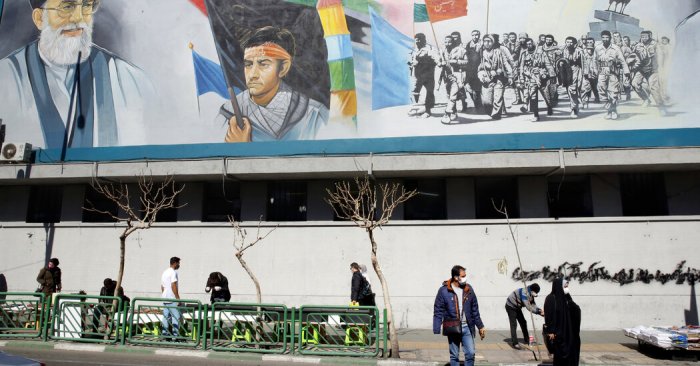
The future trajectory of US-Iran relations hinges on a complex interplay of factors, from the outcome of potential negotiations to the escalation of tensions. Predicting specific outcomes is inherently challenging, but examining potential scenarios illuminates the spectrum of possibilities and their potential regional and global implications. The stakes are high, impacting not only the stability of the Middle East but also global energy markets and security.The current standoff presents a critical juncture.
The path forward, whether it leads to a negotiated resolution or further conflict, will significantly shape the geopolitical landscape for years to come. Understanding the potential outcomes is paramount to assessing the risks and opportunities inherent in the situation.
Potential Outcomes of Negotiations
A successful negotiation, even if limited in scope, could lead to a significant de-escalation of tensions. This could involve a gradual reduction in military activities, a restoration of diplomatic channels, and the easing of economic sanctions. Such an outcome could potentially foster a more stable regional environment, allowing for greater cooperation on shared concerns, like counter-terrorism efforts and regional development.
Examples of successful, though limited, de-escalation processes exist in other regions, providing a potential model for resolution. However, the inherent mistrust and historical animosity between the two nations would likely present formidable obstacles to sustained cooperation.
Potential Outcomes of Continued Conflict
Continued conflict could result in a further escalation of tensions, potentially involving military confrontation. This could destabilize the region, leading to a humanitarian crisis and displacement of populations. The conflict could also trigger wider regional conflicts, drawing in other actors and potentially leading to a more volatile and unpredictable international environment. Historical precedents, like the Iran-Iraq War, highlight the destructive potential of prolonged regional conflicts.
The consequences would likely be felt far beyond the immediate region, impacting global energy supplies and potentially triggering economic repercussions.
Potential Challenges and Opportunities for Peace
Negotiations, if successful, present opportunities for regional stability, economic cooperation, and a reduction in global tensions. However, challenges include overcoming deep-seated mistrust, negotiating complex issues, and achieving broad regional consensus. Building trust requires sustained dialogue and concrete actions demonstrating a commitment to peaceful coexistence. Opportunities for peace often emerge from unexpected partnerships and cooperation on shared concerns. The potential for a regional security pact, for example, could offer a framework for addressing common threats and fostering stability.
Implications for Global Security
The conflict’s implications for global security are substantial. A prolonged period of tension could lead to instability in the Middle East, potentially impacting global energy markets and trade routes. The proliferation of weapons of mass destruction, even in the absence of direct conflict, poses a serious threat to global security. The current geopolitical landscape is characterized by interconnectedness, meaning that events in one region can quickly ripple through the global system.
Table of Potential Scenarios
| Scenario | Outcome for US | Outcome for Iran | Regional Impact | Global Impact |
|---|---|---|---|---|
| Negotiated Resolution | Reduced regional tensions, potential economic gains | Lifting of sanctions, access to global markets | Increased stability, reduced violence, improved relations with regional allies | Reduced global tensions, potential for greater cooperation |
| Escalation of Conflict | Increased regional instability, potential military engagement | Further isolation, potential for loss of territorial integrity | Increased violence, humanitarian crisis, regional instability | Disruption of global energy supplies, potential for wider conflict |
| Status Quo | Continued tensions, limited engagement | Continued isolation, limited economic growth | Regional instability, limited cooperation | Global uncertainty, limited progress in addressing shared challenges |
Conclusive Thoughts
In conclusion, the Trump Iran nuclear program talk reveals a deeply intertwined and complex issue with far-reaching consequences. The historical context, the differing approaches of administrations, and the reactions of both nations highlight the multifaceted challenges in resolving the conflict. Potential future scenarios, regional impacts, and the role of the international community are all critical factors in understanding the potential for a diplomatic solution or the continuation of the conflict.

